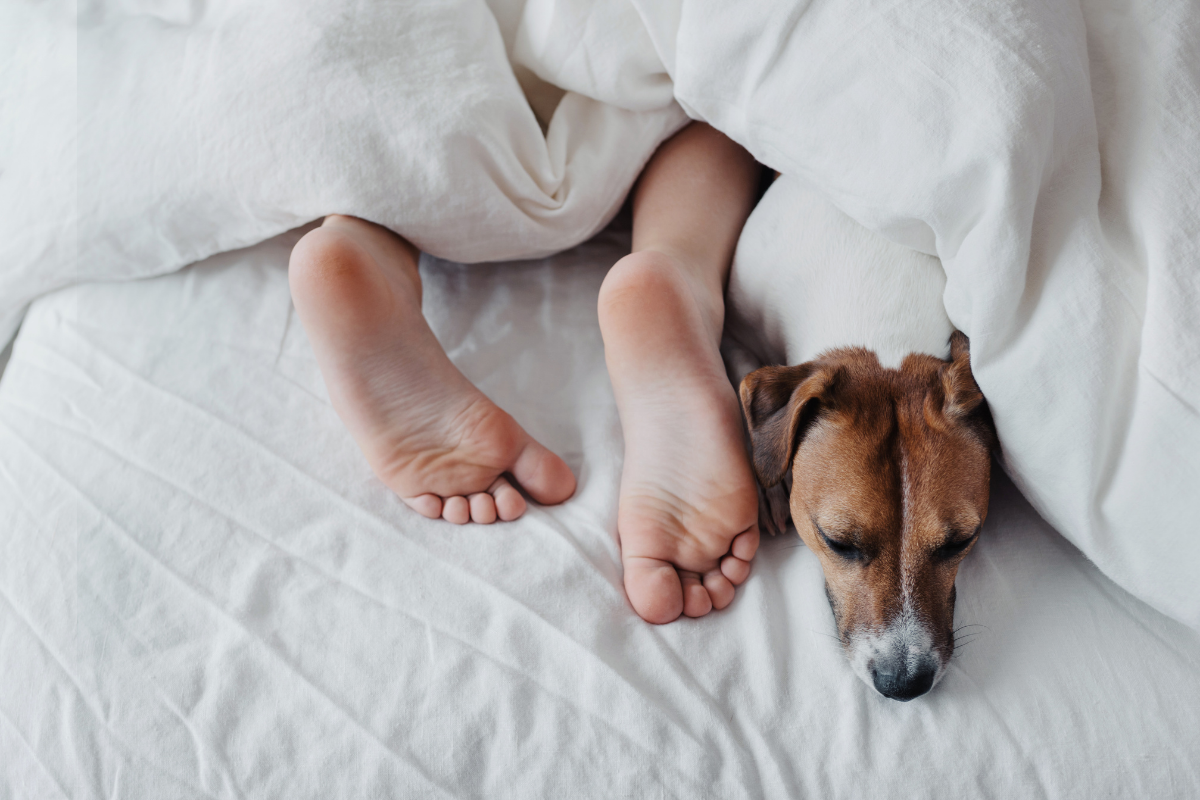This guest post was written by John Woods, Founder at All Things Dogs
We’ve all watched our dogs when they are asleep—but have you ever wondered what your dog might be communicating with the position he chooses to nap in? This article will tell you about 6 of the most common sleeping positions in dogs, why your dog might choose them, and what each can tell you about your dog.
1. Curled up

Sleeping curled up in an adorable ball is perhaps one of the most common positions you’ll see dogs asleep in. But why do so many scrunch up their heads and tails into their bodies before settling in for a nap?
The answer comes down to their instincts: in the wild, dogs accomplish multiple things by sleeping curled up.
First, this position conserves body heat. Secondly, it feels safe. Curling up leaves no vital organ exposed, which protects the dog in case they are attacked at night. Your domestic pup doesn’t need to worry about freezing temperatures or predators, but this instinct means that many dogs still sleep curled up. On top of protection and warmth, this position is also extremely comfortable!
2. Cuddling you

Consider yourself lucky if you have a dog who loves to cuddle! Cuddling with an animal has been proven to increase the hormone oxytocin and can reduce stress in both you and your dog.
Dogs who snuggle up to their owners to sleep tend to be extremely affectionate and loyal—getting close to you while you sleep is a way for them to show their love.
Practically, it also keeps them warm—many dogs who stick to you like Velcro in the winter tend to want their own space in the hotter months.
3. At your feet

In the wild, dogs are pack animals, and are programmed to protect their leader. In your home, you are the pack leader, and by settling down near you, but at the far end of the bed, your dog is positioning himself to protect you from any dangers. This behavior means that your dog will usually be loyal and affectionate when he’s awake, but watch out for signs of him being overly protective: showing stress or aggression when others come near you, or separation anxiety when you leave.
While your dog can’t tell you with words how he’s feeling, you can learn to read his body language. Some signs he might be feeling uneasy or aggressive include: a stiff tail, bared teeth, alert ears, and hackles (the hair on their backs) standing up.
4. On their belly

There are three main reasons you’ll find dogs sleeping on their stomachs.
First, this is a popular position for puppies! It is easy to get up from and is perfect for energetic youngsters who like to waste no time between napping and playing.
Second, if your adult dog sleeps on his stomach, this could be a sign that he’s a little uneasy of his surroundings. This position protects his vital organs from nighttime predators, and the ease of standing up means he can be quick to defend himself against attack. If your dog only ever sleeps on his stomach and is timid during the day, try to help him feel comfortable by providing a safe, quiet place to sleep.
Third, dogs may nap on their stomachs during the day if they are bored. This is not typically a deep sleep—they have simply dozed off while they wait for something more exciting to come along.
5. On their back

Also sometimes called “crazy legs,” this position is quite a sight to take in: your dog on her back, legs stretched out in every direction.
If this is one of your dog’s regular naptime poses, she’s probably trusting, affectionate, and goofy during waking hours. However, if you notice your dog suddenly start to move into this position, she may be trying to cool herself down.
Taking up space, panting, and exposing their stomach and paw pads to the air is an instinctual way dogs cool themselves down—just like you might spread your arms and legs out when you find yourself overheating.
6. On their side

It can be a joy to watch dogs sleep on their sides—none of their limbs are restrained in this position, so you get to see all their funny movements like running, twitching, and flopping. If your dog lies down on his side to sleep, it means that he trusts you. By exposing the vital organs that would be protected if he were curled up or on his stomach, he is showing you that he feels safe and protected around you.
It is likely that your dog who likes to sleep on his side is loving and sociable when he’s awake.
Summary
It is common for dogs to vary their sleeping position based on the weather, the environment, and even their mood. Now that you have a little insight into how your dog is feeling based on how they sleep, you can make decisions as an owner to help them get their zzz’s—turning up the AC if your pooch is suddenly sleeping on her back, or putting a blanket over a crate to make a “cave” if your dog always sleeps on his belly, for example.
What position does your dog like to sleep in? Does he/she have a favorite we didn’t include on this list? Let us know in the comments below!







